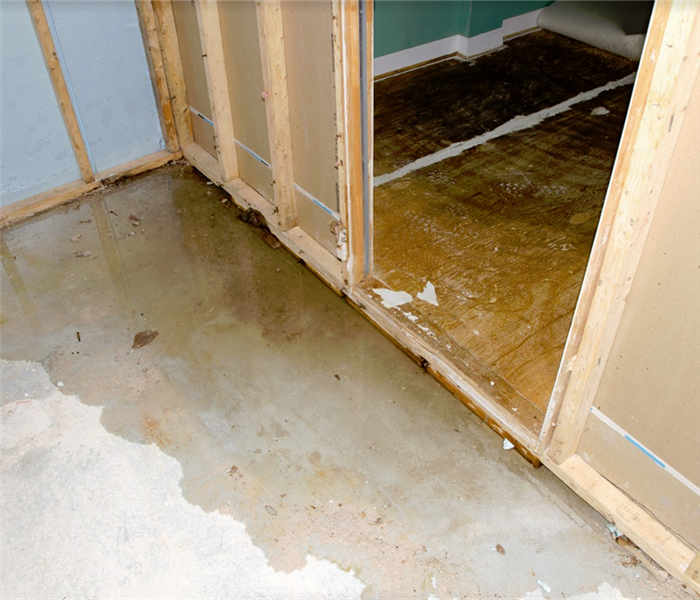How Can Water Get Removed from Ceiling Materials in My Newark Home?
8/27/2020 (Permalink)
 Water can get into your drywall and insulation and create many problems for your home. Contact SERVPRO for professional water damage remediation.
Water can get into your drywall and insulation and create many problems for your home. Contact SERVPRO for professional water damage remediation.
The migration of water can happen quickly, leaving ceiling materials and other susceptible surfaces threatened by saturation and deterioration.
When water service must reach the second story of your Newark home, its path through the property must often get concealed in structural cavities between the floor and ceiling. When age or an air hammer in the line causes damage to a portion of the plumbing, this breach can affect many of the neighboring materials surrounding it. While the flooring above the break in the pipe can also become damaged by spraying water, gravity tends to create a situation where ceiling materials suffer the brunt of these compromising conditions.
Water damage restoration in Newark homes and businesses encompasses many actions taken throughout the recovery process. For example, addressing the water damage in your house is more than water removal and drying, as repairs and even reconstruction are often necessary with plumbing breaks between the floors. Understanding how water moves and what materials can become affected can help homeowners appreciate the value of the experience and industry-leading equipment that our SERVPRO team provides.
How Does Water Move Through These Systems?
Ceilings often get comprised of many materials that make up a greater system. While you often notice damage to these surface materials you can see before you recognize a problem taking place, often, the other materials within this system have already become more heavily saturated. Elements like insulation can become weightier after absorbing water from the break, making it more likely that building materials around the insulation can begin to sag underneath the heavier load. Understanding how water moves through these materials can help our technicians to choose the best potential path to drying the damage. With these types of ruptures, migration occurs in several ways:
- Liquid – The physical movement of fluid, such as runoff, spray, and flow from the busted pipes, can be the most direct path for water to take through ceiling materials.
- Atmosphere – Prolonged moisture exposure can modify the humidity levels in the house and cause several porous materials used in ceiling systems to become saturated or affected by these changing conditions.
- Capillary Suction – Water can get pulled through pores in building materials such as drywall or ceiling tiles, which can directly impact other contents and materials on the level beneath the break.
Where Are Unseen Moisture Pockets?
A detrimental situation that can exist when water begins to move through ceiling systems is the moisture and dampness that you cannot see. These pockets of water can create damaging conditions in your Newark home such as structural deterioration or the potential growth of microbial threats. Understanding how moisture and water are moving through the materials, even where you cannot see it, impacts the choices made to dry the structure. The better the understanding of these damp areas, the more thorough drying can become, and the more of the materials affected that can be preserved. Some of the ways that we can identify moist areas within the damaged materials include:
- Surface Moisture Meters
- Hygrometers
- Thermal Imagery
How Can Water Get Removed from These Materials?
Understanding the processes to remove water from these affected materials is critical. Often homeowners might be under the impression that it is impossible to protect or preserve saturated materials once water has moved through them. Structural deterioration can exist after prolonged exposure, making the restoration or recovery of these items impossible. When approached quickly enough, and in the right circumstances, individual pieces of equipment in our inventory can directly affect impacted materials like drywall, insulation, and wood framework. These include:
- Positive Pressure Systems – By creating manageable holes or openings to the structural cavity beyond ceiling drywall or tile, we can focus blasts of heated air into these spaces to promote evaporative drying.
- Direct Drying with Air Movers – By removing portions of damaged materials through controlled demolition, we can then provide immediate access to the worst affected areas around the plumbing break. Centrifugal air movers direct dry air at these compromised surfaces for efficient drying.
- Dehumidification – We have multiple dehumidifiers in our inventory, though desiccants often have the most significant initial impact on widespread moisture concerns. These units can exhaust dry air back into affected spaces, making drying and moisture removal more efficient.
It is not impossible to preserve and protect damaged materials after a plumbing break happens between the ceiling and floor of your first and second story. With a team of in-house contractors, we can offer immediate repairs, controlled demolition, and build back after drying completes. Give our SERVPRO of Newark team a call to help when you need it at (302) 733-7933.






 24/7 Emergency Service
24/7 Emergency Service